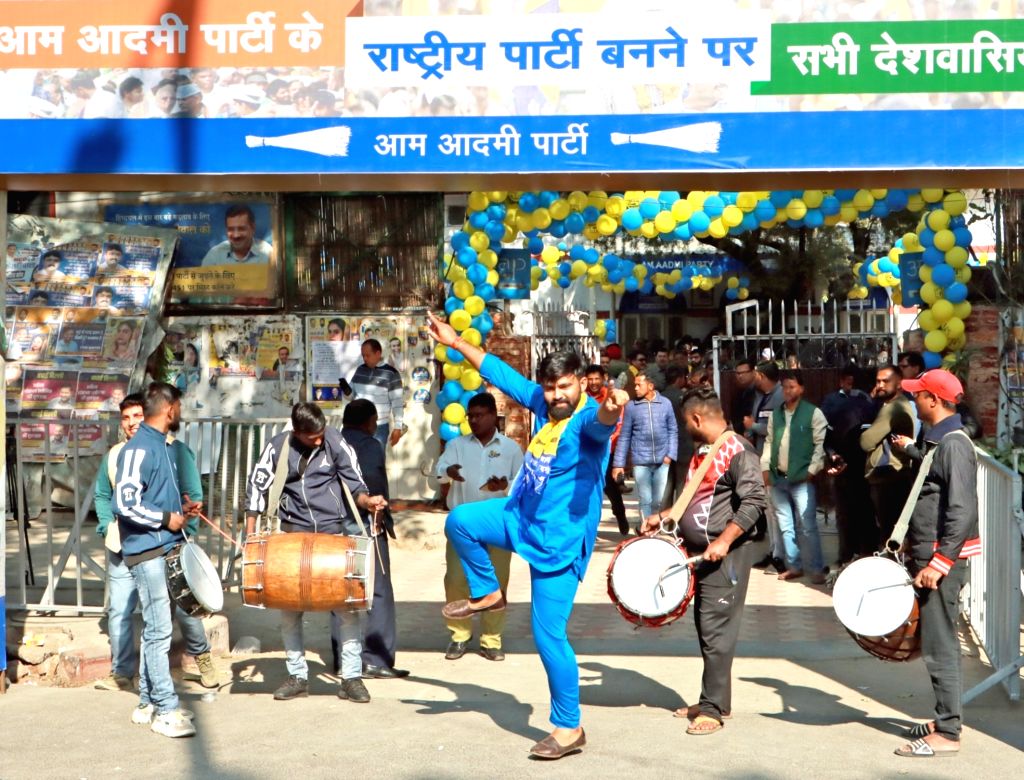
Though written off by many in Gujarat, AAP managed to breach Modi-Shah’s fortress to some extent. With most of the candidates fielded by AAP being first timers, the party still managed to bag five seats including two held previously by BJP and two by Congress, writes Aayush Goel
Zero in Himachal Pradesh and single digit in Gujarat but still Aam Aadmi Party has a spring in its stride and celebration in ranks. The decade old party, known for its ‘health and education’ promises, has finally arrived and transformed into a national party. The party is celebrating the 12.9-per cent vote share with six per cent vote share in at least four states: Delhi, Punjab, Goa and now Gujarat. In several of the 34 seats in Gujarat where it came second, it polled over 20 per cent of the vote.Victory in Gujarat made BJP the only party other than the Communist Party of India (Marxist) to have won seven straight assembly elections. The CPI (M), which ruled West Bengal for 34 years from 1977 to 2011, had also won seven straight elections.
Meanwhile, an elated party supremo and Delhi CM Arvind Kejriwal said in a video message: “Gujarat’s people have given us the national status that only a few parties have. It’s an amazing achievement for a small, young party.” With Punjab and Delhi under its wings and newly achieved status of national party AAP is now focussed on mission 2024. Senior party leader and MP Sanjay Singh says they have moved to the next battle of Modi versus Arvind Kejriwal in 2024. “Ten years and we went on from being a movement to the fastest growing political party to national party in 10 years. Now we are up for our ultimate role to take on the biggest political party in 2024. It will be Modi versus Kejriwal,” said Singh.
The Gujarat feat
While the party was written off by many with Gujarat polls being called Congress-BJP fight, AAP managed to breach Modi-Shah’s fort in Gujarat. Majority of candidates fielded by AAP on 180 seats were first timers and the party still managed a win on five seats including two held previously by BJP candidates and two by Congress. Though over 120-odd AAP candidates lost their deposits for not getting even one-sixth of the total votes polled and top leaders like chief ministerial face Isudan Gadhvi, state unit president Gopal Italia, former Patidar agitation leaders Alpesh Kathiria, Manoj Sorathiya, Dharmik Malaviya were vanquished but it got a toe hold in Gujrat. It won five seats, four in Saurashtra and one tribal seat in South Gujarat. More significantly, by pocketing a popular vote of 12%, AAP gained the national party status. Amongst the winners, AAP’s Bhupendra Bhayani defeated Harshad Kumar Ribadiya who had won from Congress in 2017 and had switched to BJP this year from Visavadar. Bhayani got 45 percent of the vote share in the seat which was former CM Keshubhai Patel’s stronghold. Similarly, in Jamjodhpur, AAP’s Hemantbhai Ahir defeated Congress Candidate with 47 per cent of vote share. AAP’s Sudhir Vaghani and Umesh Makwana are star winners who secured BJP-held seats of Gariadhar and Botad, respectively. AAP’s Chaitar Vasava made a mark in Tribal Gujarat winning the reserved ST seat of Dediapada with 55 per cent of the vote share. AAP emerged second in total 34 seats and managed to get an average of 20% of the votes. “We are just a decade old party that talks of common man issues and promises development. We may have not replicated Delhi or Punjab here but made a dent in Modi-Shah winning streak and Gujarat elections has transformed the party, our candidates got major vote share even where they lost. This highlights that we have made an entry and will soon win,” says party state president Gopal Italia.
MCD win set the tone
While Gujarat gave the party its ‘national’ tag it however won in Delhi civic elections which started the carnival for Gujarat. The fact that just a day before the BJP’s Gujarat success, AAP defeated BJP in Municipal Corporation Delhi elections inspite of huge odds proved the party’s grit and mettle.
AAP had the odds stacked against it like elections being delayed from March to December, municipal ward boundaries changed, its leaders charged with corruption and some stalwarts even sent to jail. The BJP gave it all it had in these elections with several union ministers and even the PM taking part in the election campaign. But still, AAP prevailed, ending the 15-year run of BJP in MCD.
Out of 250 wards, the party won 134, while the BJP got 104, and the Congress could secure only 9. The victory means that AAP took control of the civic body for the first time in the national capital where it has a government. The party will now finally be able to deal with control over key civic sectors, such as waste management, primary education in corporation schools and collection of property tax. It was not just the win but also the share of votes which left the party in a promising position.
The AAP’s vote share stood at 42.05 per cent this time as compared to 26.23 per cent in 2017. This increase is along expected lines, since it had won just 48 out of 270 seats in the last elections. The victory was a special win for the party as Delhi is where the story started in 2013, riding on the popularity of the Anna Hazare-led anti-corruption movement. The win also gave a blow to desire to dominate every tier of the government local, state and central.
Taking a modest route with a win, Kejriwal went ahead talking about an inclusive approach to governance “Aaj tak jitni rajneeti karni thi, kar li. Ab milkar kaam karna hai (Whatever politics had to be done, is done. Now we have to work together)… For those who did not vote for us, I want to tell them that we will first complete their pending work. We need the support of all, especially the central government. From this stage, I seek the blessings of the Prime Minister and the Centre to fix Delhi,” he said.
Punjab cabinet reshuffle on cards?
Every time AAP scores, the memories of Punjab landslide victory is refreshed in their minds. It was the party’s first win outside Delhi. It won 92 out of 117 assembly seats defeating many heavy weights including five-time chief minister Parkash Singh Badal, two-time chief minister Amarinder Singh, former deputy chief minister Sukhbir Singh Badal and state Congress party chief Navjot Singh Sidhu. The win changed the state’s decade’s old politics forever and highlighted voter’s need for change and hope.
Now, a day after the Gujarat and Himachal Pradesh Assembly poll results, a post-mortem of the performance of all AAP ministers, MLAs and office-bearers of the party unit in the state has begun in Punjab. The report card of all functionaries in the party and in the government is expected to be presented at the meeting of the party’s national executive scheduled for December 18 in Delhi.
As the party has started the exercise, speculation is rife about changes being made in the state party’s organisational structure. A reshuffle in the state cabinet could also be effected after this meeting.
Himachal: A lost chance?
While AAP has a lot to celebrate but the Himachal defeat has left many disheartened. The local leaders feel that while chasing the Gujarat dream they lost out on Himachal. As per the latest poll results, the party got a little over 1% of the vote share. AAP candidates lost their security deposits in most of the state’s 68 constituencies.
Soon after AAP won the Punjab assembly elections in March this year, pollsters were confident that AAP would do well in neighbouring Himachal Pradesh too but it failed “We had a good chance that we messed up. We were doing great till June and July but everything went haywire since then as we were abandoned for Gujarat,” said a senior party leader. The local leaders feel AAP could have dealt with both states but Himachal was abandoned. During the course of the campaign here, the party changed its state in-charge thrice – first it was Durgesh Pathak, then Sandeep Pathak and then Harjot Bains, a minister in the party’s Punjab government. So, this election season left AAP with a lot to celebrate. However, there were also some lessons to be learnt for the fast growing party.












